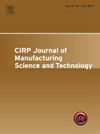Surface topography and cross-section analysis of K340 cold work tool steel double-tracks deposited by directed energy deposition technique
IF 5.4
2区 工程技术
Q2 ENGINEERING, MANUFACTURING
CIRP Journal of Manufacturing Science and Technology
Pub Date : 2025-04-02
DOI:10.1016/j.cirpj.2025.03.011
引用次数: 0
Abstract
Tool steels are widely used as dies and tools due to their exceptional properties. However, cracking and wear can significantly impact the performance and longevity of the tools. The possibility of repairing the damaged parts by Directed Energy Deposition (DED) results in an extended tool life and improved environmental impact compared to traditional techniques. To this purpose, the current study aims at investigating the processability of K340 cold work steel by DED. To study the processing window, based on a face-centered composite design, double-tracks with different sets of nozzle travel speed (), laser power (P), and carrier gas flow rate () were deposited. Deposits were characterized by scanning electron microscopy (SEM), coherence scanning interferometry (CSI), and micro-instrumented indentation, and quantitative analysis of influence factors was performed by ANOVA and response surface methodology. The results showed that increasing P and decreasing resulted in an improved surface roughness. However, surface features describing extreme values, such as Sp and Sz, showed the presence of not fully incorporated particles. Additionally, showed no significant effect on parameters describing the average roughness, such as Sa, Sq and Sdq. Cross-section analysis revealed that almost defect-free deposits can be made with a porosity fraction area of as low as 0.04 %. However, the deposited material showed a different microstructure than that of the substrate, and heat affected zones were also observed. By increasing P, the dilution tended to rise from 5 % to 36 %. The laser power was shown to be the main parameter affecting the dilution. The process optimization to have the best possible combination of high geometrical accuracy and low surface roughness and low defect level was implemented and validated by experimental results. By investigating the processing window and optimizing the process, this study facilitates the application of DED as a repairing process of K340 tools and contributes to sustainable manufacturing.
定向能沉积技术沉积K340冷作工具钢双轨的表面形貌及截面分析
工具钢由于其特殊的性能被广泛用作模具和工具。然而,开裂和磨损会严重影响工具的性能和使用寿命。与传统技术相比,通过定向能沉积(DED)修复受损部件的可能性可以延长工具寿命,改善环境影响。为此,本研究的目的是利用DED技术研究K340冷作钢的可加工性。为了研究加工窗口,基于面心复合设计,沉积了不同喷嘴行程速度(vN)、激光功率(P)和载气流速(Vcg)组的双轨。采用扫描电镜(SEM)、相干扫描干涉测量(CSI)和微仪器压痕法对沉积物进行表征,并利用方差分析和响应面法对影响因素进行定量分析。结果表明,增大P和减小vN可以提高表面粗糙度。然而,描述极端值的表面特征,如Sp和Sz,表明存在未完全结合的颗粒。此外,Vcg对描述平均粗糙度的参数,如Sa、Sq和Sdq没有显著影响。横截面分析表明,在孔隙率低至0.04%的情况下,几乎可以形成无缺陷的镀层。然而,沉积材料的微观结构与基体不同,并且存在热影响区。随着P的增加,稀释度趋于从5%上升到36%。激光功率是影响稀释的主要参数。实现了高几何精度、低表面粗糙度和低缺陷水平的最佳组合的工艺优化,并通过实验结果进行了验证。本研究通过研究加工窗口和工艺优化,促进了DED作为K340刀具维修工艺的应用,有助于可持续制造。
本文章由计算机程序翻译,如有差异,请以英文原文为准。
求助全文
约1分钟内获得全文
求助全文
来源期刊

CIRP Journal of Manufacturing Science and Technology
Engineering-Industrial and Manufacturing Engineering
CiteScore
9.10
自引率
6.20%
发文量
166
审稿时长
63 days
期刊介绍:
The CIRP Journal of Manufacturing Science and Technology (CIRP-JMST) publishes fundamental papers on manufacturing processes, production equipment and automation, product design, manufacturing systems and production organisations up to the level of the production networks, including all the related technical, human and economic factors. Preference is given to contributions describing research results whose feasibility has been demonstrated either in a laboratory or in the industrial praxis. Case studies and review papers on specific issues in manufacturing science and technology are equally encouraged.
 求助内容:
求助内容: 应助结果提醒方式:
应助结果提醒方式:


